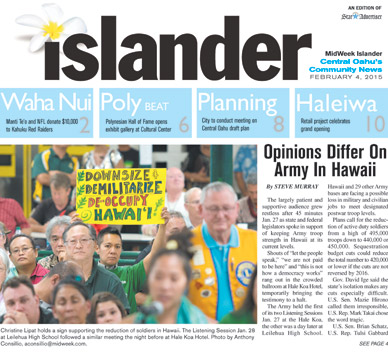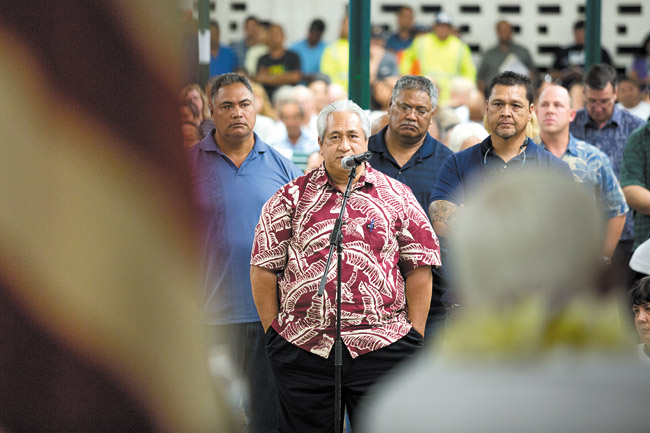Opinions Differ On Army In Hawaii
The largely patient and supportive audience grew restless after 45 minutes Jan. 27 as state and federal legislators spoke in support of keeping Army troop strength in Hawaii at its current levels.
Shouts of “let the people speak,” “we are not paid to be here” and “this is not how a democracy works” rang out in the crowded ballroom at Hale Koa Hotel, temporarily bringing the testimony to a halt.
co-020415-leilehua-meeting-ac-04
The Army held the first of its two Listening Sessions Jan. 27 at the Hale Koa, the other was a day later at Leilehua High School.
Hawaii and 29 other Army bases are facing a possible loss in military and civilian jobs to meet designated postwar troop levels.
Plans call for the reduction of active duty soldiers from a high of 495,000 troops down to 440,000 or 450,000. Sequestration budget cuts could reduce the total number to 420,000 or lower if the cuts are not reversed by 2016.
Gov. David Ige said the state’s isolation makes any cuts especially difficult. U.S. Sen. Mazie Hirono called them irresponsible, U.S. Rep. Mark Takai chose the word tragic.
U.S. Sen. Brian Schatz, U.S. Rep. Tulsi Gabbard and state Sen. Will Espero highlighted President Obama’s focus on the Asia/Pacific region and possible military and economic threats from China and North Korea.
An environmental assessment (EA) supplement to the Army’s 2020 Force Structure Realignment report listed possible cuts of nearly 20,000 military and civilian jobs at Schofield Barracks and Fort Shafter. The cuts also would affect more than 30,000 family members and cost the state $1.35 billion.
A petition by Chamber of Commerce of Hawaii and Keep Hawaii’s Heroes gathered more than 42,000 signatures against cutting civilian and military jobs in Hawaii.
On Jan. 22, the state Senate and House of Representatives voted on a concurrent resolution opposing Army personnel reductions.
The vote was unanimous, except for one.
State Rep. Kaniela Ing, chair of the committee on Ocean, Marine Resources and Hawaiian Affairs, voted against the resolution, saying a reduction would force Hawaii to begin long-term planning for the diversification of the economy.
“I am sympathetic toward the plight of the soldiers, their families and the businesses around the bases, but we have to look at it long term,” he said. “That $1.35 billion could be used to develop agriculture, technology, a whole slew of entrepreneurships in the near future.”
In his address to Army officials, Mayor Kirk Caldwell pointed to the closing of Kalaeloa as evidence of the state’s inability to develop former military property. A point of interest for some in attendance was the possibility of turning over a portion of Schofield Barracks to the state for redevelopment as housing. Ing, who represents South Maui, dismissed the idea that the land would go fallow.
“There are places the military has left, on the Mainland and abroad, where the transition has been smooth, and it’s because they focused on those efforts instead of just opposing the closings.
“No military installation is forever, and we can’t keep kicking the can down the road.”
Ing said base closures or troop reduction needs to include federal assistance in land acquisition, development and clean up.
He also mentioned the desire for the Army to begin paying for it’s use of Hawaiian Home Lands property, an issue seemingly supported by a number of Native Hawaiians in attendance who called for such programs and for the removal the Army in Hawaii.
Testimony from the two listening sessions will be presented to Army leaders in Washington. A decision on the cuts could come by mid-2015.







